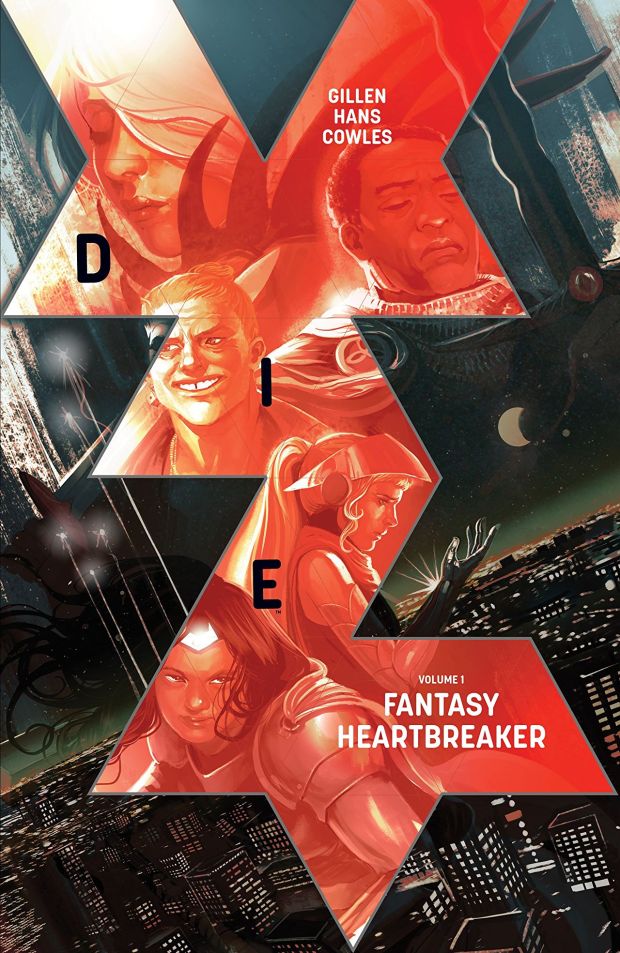by Kieron Gillen, Jamie McKelvie, Matt Wilson, and Clayton Cowles
collects WicDiv #40-45
volumes four | six | seven | eight | nine
The Wicked + the Divine, a five-year story by dream team and longtime collaborators Gillen, McKelvie, Wilson and Cowles, finally comes to a close.
Admittedly, I procrastinated reading the final volume for months. WicDiv was the first Image book, and I think the first non-superhero comic, that I really loved. I was spellbound from the first volume: a pantheon of teenage gods, blending mythology and a commentary on celebrity and social media obsession, and art like I had never seen before. (Spoiler: still haven’t.) For years, there was always another volume to look forward to. And now it’s over.

If you’ve made it to volume nine, congratulations. It’s worth it, but it was a long and often confusing journey. With months or years between volumes, many details – from minutiae to major reveals – got lost. There were still plenty of things I didn’t understand, but it was still a satisfying ending.
WicDiv will be best enjoyed by new readers now that the complete story is out, or rereading the series in full by older fans. In their interview with Polygon, Gillen and McKelvie discuss how plotting out a five year creator owned story allowed them to create to the fullest and also build in a whole lot of foreshadowing. It also limited them in interesting ways, especially as their primary work for half a decade. (I highly recommend the interview.) So even if the big reveals seem out of left field, rest assured that the creators always had the ending, and even the final dialogue, planned from the start. This is the strength of Image and other publishers that allow comics to be fully owned by their creators. It’s theirs from beginning to end.

As far as the story itself, Gillen holds nothing back: the final questions are answered, final deaths and rebirths may shock you, and a thrilling end to the war balancing action, dialogue, and both symbolic and literal closure. The secret that Ananke and Minerva are one quickly gets out, and our teens react very differently; the severed (but very much alive) heads allow for emotional reunions, and the surprising conclusion and second to last issue is as simple as it is brilliant. On a personal note, I was frustrated with Persephone/Laura for the last few volumes but she has a strong conclusion here – as do all the members of our surviving pantheon.
The final issue, an epilogue with a time jump, was the most emotional in the volume. I’d seen the final cover (kept secret until its release, for spoiler reasons), but this issue still has a few surprises and not too much explanation, which I was grateful for.
The celebrity and social media obsession commentary also returns in the finale. It was almost completely lacking in volume eight, a specials compilation*, and volume seven focused on pantheon mythology. Even though the commentary has a stronger presence, it doesn’t overstate its intentions in the story, yet its meanings to both our pantheon teenagers and the readers are absolutely clear.
*just a note that volume eight can be skipped, but there are a few small references to it in the conclusion!

McKelvie, Wilson and Cowles have long been experimenting with art, panels and colors in WicDiv (among my favorites, Dionysus’ epic rave and distilling millennia of history in repeating panels) and it was glorious to see their last hurrah in these final pages. Like Gillen, they hold nothing back in this issue, and their visually stunning (dare I say, divine) teamwork is firing on all cylinders. Cowles’ lettering actually becomes more important as a visual cue in ways that I won’t spoil, but for those who haven’t taken yet appreciated his fantastic work, please revel in its glory.
If the end of WicDiv wasn’t difficult enough, seeing the band break up is even harder. It’s hard to find creative teams as daring, playful and sharp as this one. The creators confirmed they won’t collaborate on a long project like this again, I hope we see these four names on a cover again, even if they have to take a break for a while and pursue other work.
This series means a lot to me; instead of saying goodbye, it has to be, until the next reread. Thank you, and:












 But I personally didn’t find most of the stories particularly affecting or interesting. There was some extreme gore and disturbing stuff in the first issue that set me off for the rest of the book. I didn’t find my investment in characters I already love, or don’t care for, changing all that much. I was surprised that Persephone took a backseat. And it was a disappointment that the most visually interesting special, set in the 1920’s (and a lovely homage to Agatha Christie), was largely written in prose.
But I personally didn’t find most of the stories particularly affecting or interesting. There was some extreme gore and disturbing stuff in the first issue that set me off for the rest of the book. I didn’t find my investment in characters I already love, or don’t care for, changing all that much. I was surprised that Persephone took a backseat. And it was a disappointment that the most visually interesting special, set in the 1920’s (and a lovely homage to Agatha Christie), was largely written in prose.







